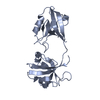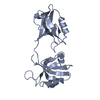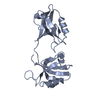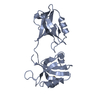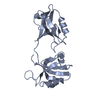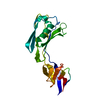[English] 日本語
 Yorodumi
Yorodumi- SASDGG5: The PDZ1-2 domain of postsynaptic density protein 95 (PSD-95) (Pa... -
+ Open data
Open data
- Basic information
Basic information
| Entry | Database: SASBDB / ID: SASDGG5 |
|---|---|
 Sample Sample | The PDZ1-2 domain of postsynaptic density protein 95 (PSD-95) (Paused SEC)
|
| Function / homology |  Function and homology information Function and homology informationLGI-ADAM interactions / P2Y1 nucleotide receptor binding /  beta-1 adrenergic receptor binding / neuroligin family protein binding / NrCAM interactions / receptor localization to synapse / positive regulation of neuron projection arborization / regulation of grooming behavior / synaptic vesicle maturation / cerebellar mossy fiber ...LGI-ADAM interactions / P2Y1 nucleotide receptor binding / beta-1 adrenergic receptor binding / neuroligin family protein binding / NrCAM interactions / receptor localization to synapse / positive regulation of neuron projection arborization / regulation of grooming behavior / synaptic vesicle maturation / cerebellar mossy fiber ...LGI-ADAM interactions / P2Y1 nucleotide receptor binding /  beta-1 adrenergic receptor binding / neuroligin family protein binding / NrCAM interactions / receptor localization to synapse / positive regulation of neuron projection arborization / regulation of grooming behavior / synaptic vesicle maturation / cerebellar mossy fiber / Synaptic adhesion-like molecules / cellular response to potassium ion / protein localization to synapse / vocalization behavior / neuron spine / AMPA glutamate receptor clustering / juxtaparanode region of axon / establishment or maintenance of epithelial cell apical/basal polarity / Trafficking of AMPA receptors / dendritic spine morphogenesis / negative regulation of receptor internalization / postsynaptic neurotransmitter receptor diffusion trapping / neuron projection terminus / RHO GTPases activate CIT / Assembly and cell surface presentation of NMDA receptors / beta-1 adrenergic receptor binding / neuroligin family protein binding / NrCAM interactions / receptor localization to synapse / positive regulation of neuron projection arborization / regulation of grooming behavior / synaptic vesicle maturation / cerebellar mossy fiber / Synaptic adhesion-like molecules / cellular response to potassium ion / protein localization to synapse / vocalization behavior / neuron spine / AMPA glutamate receptor clustering / juxtaparanode region of axon / establishment or maintenance of epithelial cell apical/basal polarity / Trafficking of AMPA receptors / dendritic spine morphogenesis / negative regulation of receptor internalization / postsynaptic neurotransmitter receptor diffusion trapping / neuron projection terminus / RHO GTPases activate CIT / Assembly and cell surface presentation of NMDA receptors /  acetylcholine receptor binding / Neurexins and neuroligins / neurotransmitter receptor localization to postsynaptic specialization membrane / Activation of Ca-permeable Kainate Receptor / cortical cytoskeleton / Signaling by ERBB4 / Negative regulation of NMDA receptor-mediated neuronal transmission / Unblocking of NMDA receptors, glutamate binding and activation / locomotory exploration behavior / acetylcholine receptor binding / Neurexins and neuroligins / neurotransmitter receptor localization to postsynaptic specialization membrane / Activation of Ca-permeable Kainate Receptor / cortical cytoskeleton / Signaling by ERBB4 / Negative regulation of NMDA receptor-mediated neuronal transmission / Unblocking of NMDA receptors, glutamate binding and activation / locomotory exploration behavior /  regulation of NMDA receptor activity / regulation of NMDA receptor activity /  social behavior / positive regulation of excitatory postsynaptic potential / social behavior / positive regulation of excitatory postsynaptic potential /  Long-term potentiation / AMPA glutamate receptor complex / neuromuscular process controlling balance / Long-term potentiation / AMPA glutamate receptor complex / neuromuscular process controlling balance /  excitatory synapse / excitatory synapse /  D1 dopamine receptor binding / positive regulation of protein tyrosine kinase activity / positive regulation of synaptic transmission / D1 dopamine receptor binding / positive regulation of protein tyrosine kinase activity / positive regulation of synaptic transmission /  ionotropic glutamate receptor binding / ionotropic glutamate receptor binding /  extrinsic component of cytoplasmic side of plasma membrane / Ras activation upon Ca2+ influx through NMDA receptor / dendrite cytoplasm / extrinsic component of cytoplasmic side of plasma membrane / Ras activation upon Ca2+ influx through NMDA receptor / dendrite cytoplasm /  synaptic membrane / synaptic membrane /  learning / learning /  PDZ domain binding / postsynaptic density membrane / PDZ domain binding / postsynaptic density membrane /  adherens junction / regulation of long-term neuronal synaptic plasticity / adherens junction / regulation of long-term neuronal synaptic plasticity /  neuromuscular junction / establishment of protein localization / neuromuscular junction / establishment of protein localization /  cell-cell adhesion / cell-cell adhesion /  kinase binding / endocytic vesicle membrane / kinase binding / endocytic vesicle membrane /  synaptic vesicle / synaptic vesicle /  cell junction / cell junction /  nervous system development / positive regulation of cytosolic calcium ion concentration / chemical synaptic transmission / RAF/MAP kinase cascade / nervous system development / positive regulation of cytosolic calcium ion concentration / chemical synaptic transmission / RAF/MAP kinase cascade /  scaffold protein binding / scaffold protein binding /  postsynaptic membrane / basolateral plasma membrane / protein-containing complex assembly / postsynaptic membrane / basolateral plasma membrane / protein-containing complex assembly /  protein phosphatase binding / protein phosphatase binding /  dendritic spine / dendritic spine /  postsynaptic density / neuron projection / postsynaptic density / neuron projection /  synapse / glutamatergic synapse / protein-containing complex binding / synapse / glutamatergic synapse / protein-containing complex binding /  endoplasmic reticulum / endoplasmic reticulum /  signal transduction / signal transduction /  plasma membrane / plasma membrane /  cytosol / cytosol /  cytoplasm cytoplasmSimilarity search - Function |
| Biological species |   Homo sapiens (human) Homo sapiens (human) |
 Citation Citation |  Date: 2019 Sep 19 Date: 2019 Sep 19Title: How the dual PDZ domain from Postsynaptic density protein 95 clusters ion channels and receptors Authors: Rodzli N / Lockhart-Cairns M / Levy C / Chipperfield J / Bird L / Baldock C |
 Contact author Contact author |
|
- Structure visualization
Structure visualization
| Structure viewer | Molecule:  Molmil Molmil Jmol/JSmol Jmol/JSmol |
|---|
- Downloads & links
Downloads & links
-Data source
| SASBDB page |  SASDGG5 SASDGG5 |
|---|
-Related structure data
| Related structure data | C: citing same article ( |
|---|---|
| Similar structure data |
- External links
External links
| Related items in Molecule of the Month |
|---|
-Models
| Model #3750 |  Type: atomic / Chi-square value: 2.67  Search similar-shape structures of this assembly by Omokage search (details) Search similar-shape structures of this assembly by Omokage search (details) |
|---|---|
| Model #3751 |  Type: atomic / Chi-square value: 2.67  Search similar-shape structures of this assembly by Omokage search (details) Search similar-shape structures of this assembly by Omokage search (details) |
| Model #3752 |  Type: atomic / Chi-square value: 2.67  Search similar-shape structures of this assembly by Omokage search (details) Search similar-shape structures of this assembly by Omokage search (details) |
| Model #3753 |  Type: atomic / Chi-square value: 2.67  Search similar-shape structures of this assembly by Omokage search (details) Search similar-shape structures of this assembly by Omokage search (details) |
| Model #3754 |  Type: atomic / Chi-square value: 2.67  Search similar-shape structures of this assembly by Omokage search (details) Search similar-shape structures of this assembly by Omokage search (details) |
- Sample
Sample
 Sample Sample | Name: The PDZ1-2 domain of postsynaptic density protein 95 (PSD-95) (Paused SEC) Specimen concentration: 15 mg/ml |
|---|---|
| Buffer | Name: 20 mM TRIS/HCl, 150 mM NaCl / pH: 8.5 |
| Entity #1889 | Name: PDZ1-2 / Type: protein Description: PDZ1-2 fragment of PSD-95/Disks large homolog 4 Formula weight: 20.8 / Num. of mol.: 1 / Source: Homo sapiens / References: UniProt: P78352 Sequence: GPGTEGEMEY EEITLERGNS GLGFSIAGGT DNPHIGDDPS IFITKIIPGG AAAQDGRLRV NDSILFVNEV DVREVTHSAA VEALKEAGSI VRLYVMRRKP PAEKVMEIKL IKGPKGLGFS IAGGVGNQHI PGDNSIYVTK IIEGGAAHKD GRLQIGDKIL AVNSVGLEDV ...Sequence: GPGTEGEMEY EEITLERGNS GLGFSIAGGT DNPHIGDDPS IFITKIIPGG AAAQDGRLRV NDSILFVNEV DVREVTHSAA VEALKEAGSI VRLYVMRRKP PAEKVMEIKL IKGPKGLGFS IAGGVGNQHI PGDNSIYVTK IIEGGAAHKD GRLQIGDKIL AVNSVGLEDV MHEDAVAALK NTYDVVYLKV AKPSNA |
-Experimental information
| Beam | Instrument name: Diamond Light Source B21 / City: Didcot / 国: UK  / Shape / Shape : 1 x 5 mm / Type of source: X-ray synchrotron : 1 x 5 mm / Type of source: X-ray synchrotron Synchrotron / Wavelength: 0.1 Å / Dist. spec. to detc.: 3.9 mm Synchrotron / Wavelength: 0.1 Å / Dist. spec. to detc.: 3.9 mm | ||||||||||||||||||||||||||||||
|---|---|---|---|---|---|---|---|---|---|---|---|---|---|---|---|---|---|---|---|---|---|---|---|---|---|---|---|---|---|---|---|
| Detector | Name: Pilatus 2M | ||||||||||||||||||||||||||||||
| Scan | Measurement date: Jan 26, 2016 / Exposure time: 10 sec. / Number of frames: 69 / Unit: 1/A /
| ||||||||||||||||||||||||||||||
| Distance distribution function P(R) |
| ||||||||||||||||||||||||||||||
| Result | Comments: Scattering data are fitted using the ATSAS OLIGOMER program using a suite of models. The ATSAS program FFMAKER was used to generate form factors for each model in the suite. Each model is ...Comments: Scattering data are fitted using the ATSAS OLIGOMER program using a suite of models. The ATSAS program FFMAKER was used to generate form factors for each model in the suite. Each model is assigned a volume fraction to fit the observed scattering profile. 3 monomer models are included, the first is a compact conformation of PDZ1-2 similar to PDB entries 6spv/6spz; the other two are domain models obtained from a representative run of the ATSAS EOM program with data projected to infinite dilution. Multimeric models are drawn from a "clustering Spacegroup", unit cell 14.8nm symmetry I2(1)3, and consist of identical copies of an extended conformation of PDZ1-2 (similar to PDB entry 3zrt) assembled by symmetry operations. In the order of deposition: Model number; Stoichiometry; MW (kDa); source; Volume fraction. 1; 1; 21; Crystal Structure; 0.382. 2; 1; 21; EOM; 0.106. 3; 1; 21; EOM; 0.397. 4; 2; 42; clustering Spacegroup; 0.081. 5; 4; 84; clustering Spacegroup; 0.034.
|
 Movie
Movie Controller
Controller




